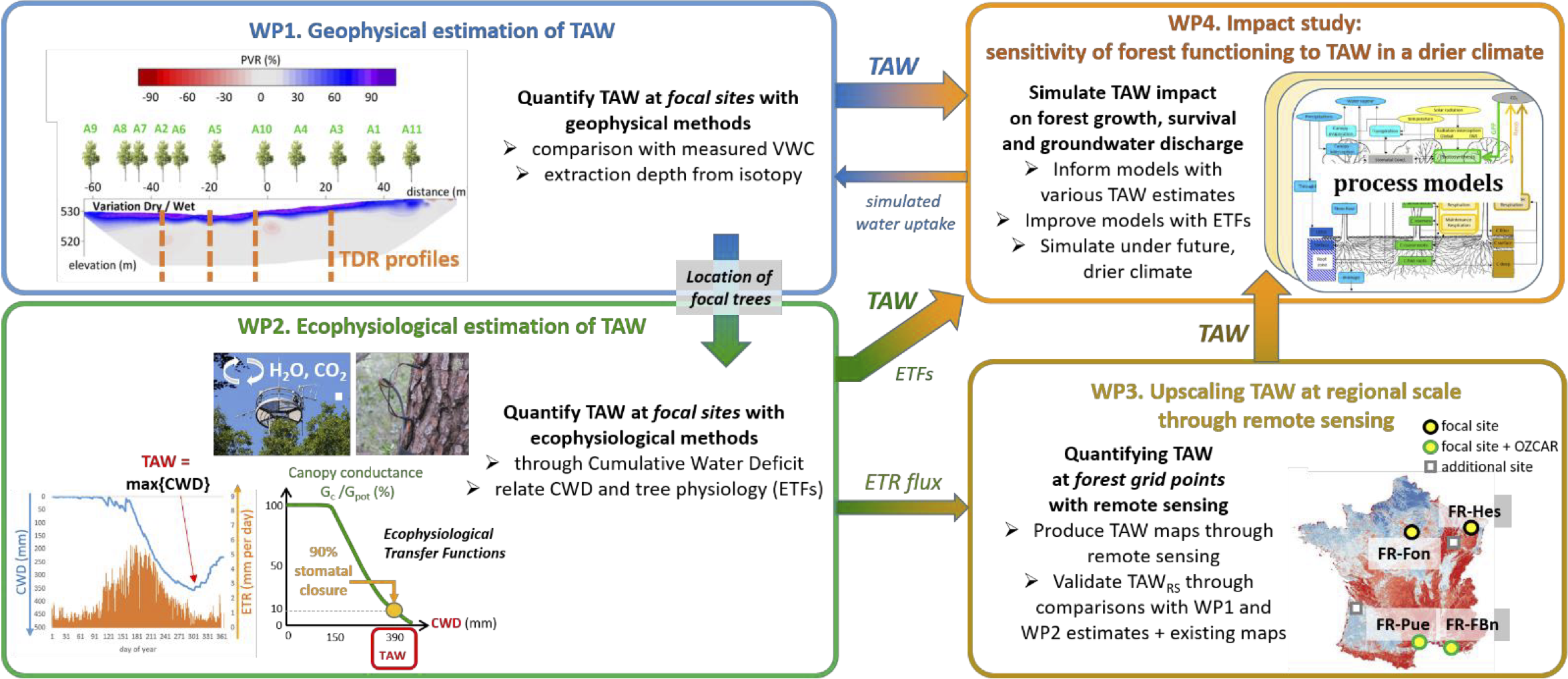TAW-tree - Total Available Water to Tree: a key, missing parameter for assessing the vulnerability of forests in the face of climate change
Funding: French National Research Agency (ANR)
Partners: ESE (Université Paris-Saclay), METIS (Université Paris-Saclay), URFM (INRAE Avignon), CEFE (CNRS Montpellier), Silva (INRAE Nancy), GEOPS (Université Paris-Saclay). Coordinated by Nicolas Delpierre (ESE)

Forests cover one-third of the Earth’s land area and are central in the global carbon and water cycles. They contribute to mitigating ongoing climate change by absorbing 25% of the annual anthropogenic CO2 emissions1. Forests also play an important role in the distribution of precipitation and continental water dynamics, contributing about 60% of land evapotranspiration. Yet the future of forests is uncertain in the current context of climate change4. This is because trees are sessile organisms that depend on soil reserves to access water. With climate change, the world’s forests, like all terrestrial ecosystems, are facing an increase in atmospheric evaporative demand. In addition, in western central Europe and the Mediterranean area, climate models predict a likely increase in edaphic droughts in the coming decades. The response of forests to increased water deficit will depend largely on their access to soil water, which is to date very poorly characterized. Therefore, we need comprehensive approaches and interdisciplinary research to take into account the hydrological and hydrogeological parameters of the critical zone in the response of forests to water deficit.
For a long time, the so-called “available water content” (AWC, in millimetres of water) has been identified as a key parameter in the modelling of forest water balance, carbon balance, tree growth and survival. Yet, the concept of AWC has two main drawbacks that question its relevance in a context of increasing water deficit, particularly in the case of forests. First, the estimation of AWC is classically based on integrating pedotransfer functions over depth of 1 to 2-meters. This considerably underestimates the capacity of trees to grow roots much deeper (down to 5-10 m in the temperate and Mediterranean zones). Challenging the AWC concept, recent works have defined the Total Available Water (TAW) concept, that adds “deep water” extraction by trees to AWC. However, this deep-water resource remains poorly quantified because the soil volume actually explored by roots is unknown. Second, the estimation of AWC is typically done at the scale of a forest stand, and does not consider the large spatial heterogeneity of its soil. A consequence of this heterogeneity is that the access to soil water can vary greatly among individual trees in a forest, mirroring the large inter-individual variability in terms of functioning18 and vulnerability to water stress that is often observed but more rarely explained, and could contribute to the forest resilience to climate extremes. At a larger spatial scale, evidence is increasing that the access to deep water (hence the estimation of TAW) will be central in the forecast of the functioning and vulnerability of temperate and Mediterranean forests to ongoing climate change.
In this context, the TAW-tree project (Fig. 1) aims (1) to quantify the TAW reserve in forest plots through a combination of geophysical (WP1) and ecophysiological (WP2) approaches, (2) to upscale TAW at regional scale using remote sensing (WP3) in order to (3) quantify the influence of TAW on the functioning, growth and vulnerability of temperate and Mediterranean forests facing climate change (WP4). Our working hypotheses are (hypothesis 1) that AWC generally underestimates TAW, often in a considerable way in forests, (hypothesis 2) that the variations of TAW in a particular forest drive a large part of the inter-tree differences in their response to water shortage, (hypothesis 3) that TAW, and particularly its deep component, has a critical role in the functioning and vulnerability of forests exposed to heat and drought stresses and that it changes the forests’ contribution to groundwater discharge.